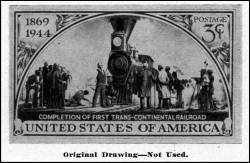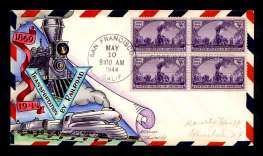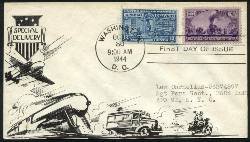
|
<<<< |

|
>>>> |

|

TRAINS ON U. S. STAMPS
and POSTAL STATIONERY
page 3

Embossed postcard with train image - 20th Century Limited |
3¢ TRANSCONTINENTAL RAILROAD ISSUE - May 10, 1944Issued to mark the 75th anniversary of the historic completion of the first transcontinental East-West railroad line in 1869, this stamp depicts the 4-4-0 type wood- burning locomotive "Jupiter" in the painting "Golden Spike Ceremony," by John McQuarrie. "Jupiter" was built in 1868 and commissioned into service just two months before the Golden Spike Ceremony. It had not been intended for this use, but took over when "Antelope", the locomotive originally intended for the purpose, was badly damaged in an accident. For more about the story behind the events depicted on this stamp, here is another article about the building of the Trans-Continental Railroad, culminating with the Golden Spike ceremony. Max Johl provided his usual essential background to the design and production aspects of this stamp.
Sooner or later someone always protests that this stamp's design is flawed, that the flag is blowing one way and the smoke another. I happen to think wind doesn't always blow so neatly, and the image could be accurate, but looking at the source mural, and considering Johl's comment that the cloud of smoke and steam was added by the stamp's designer, I can envision a different smoke cloud more consistent with the flag's direction, so perhaps the designer did exercise a bit too much artistic license. As with all commemorative stamps since the 1930's in this country, Scott 922 was issued in such a large quantity (61 Million), and saved so heavily, that it still has little more value than its face amount, 3 cents, which is fine with me, since it means I can afford to keep a stock on hand to dress up my mail.
Mellone lists 59 cacheted First Day Covers
for this stamp. The one above is an
all-time favorite of mine.
Of the 59 cachets in Mellone, 4 have a patriotic theme, reminding us that this stamp
was issued during World War II, 01/25/19 - Collector Kevin P. Tucker wrote me to say this about the "Free Frank" cover above:
Thanks, Kevin - that's a better explanation than what I would have guessed!
Here's a nice use of 922 on cover, to pay the First Class postage on this FDC for Scott E17. Before the Trans-Continental Railroad
What does the cover above have to do with this stamp? This cover is a personal favorite (though I own only a photograph from a Siegel auction catalog), because of the handstamp - Via Nicaragua, Ahead of the Mails. It dates from around 1855 (based on the stamps), and emphasizes how big a difference was made by the completion of the trans-continental railroad. In 1855, the fastest way to send a letter from San Francisco, where this originated, to the East Coast, was via an Express company, on a steamship down the West coast to Nicaragua, across the isthmus via mule and train to the Gulf of Mexico, and then via steamship up the US coast to the Northeast! I've no idea how long that journey took, but it must have been over a month; and the idea that it was faster via Nicaragua amazes me, as well as the fact that completion of the Transcontinental Railroad cut the travel time to less than a week. (The Scott US Specialized catalog shows this handstamp in the section titled "Local Handstamped Covers", under the heading "Accessory Transit Co. of Nicaragua".) So how did the "Jupiter" get to California to make its journey from West to East to participate in the Golden Spike Ceremony? There were not yet any factories west of the Mississippi capable of building locomotives. Built in Schenectady, The Jupiter travelled disassembled, by steamer, 115 days, from New York around Cape Horn, to San Francisco. Yet the moment it achieved its mission, new locomotives could be brought in within days.
By the way, the building of the Trans-Continental Railroad in the US is a fascinating
chapter in American History - an Internet search on the topic will yield you hours of
interesting reading and viewing. You may know that the line was built by two separate
companies, working from opposite sides of the country. But did you know they SHOULD
have met weeks earlier than they did, and were laying parallel
grades, because the government had granted them money (and land) per mile of track
laid, with no stipulation that they ever had to meet!? It took a special act of Congress
to force the final meeting in Promontory Summit, Utah, on May 10, 1869.
|
|||
3¢ TELEGRAPH CENTENARY ISSUE - May 24, 1944Collector Steve Okonski sent the following suggestion back in late January of 2014: I sent a non-commital reply, then copied his message to my friends at the Casey Jones Rail Road Unit of the ATA, and they published it in their newsletter, The Dispatcher. Today (5/20/2014) I received the latest issue, with the following letter from a member: Based on all of that, and in the spirit of inclusiveness, I have decided to add it here. |
US TRAINS
|
Send feedback to the webmaster: CLICK HERE
Revised -- 05/12/2019








